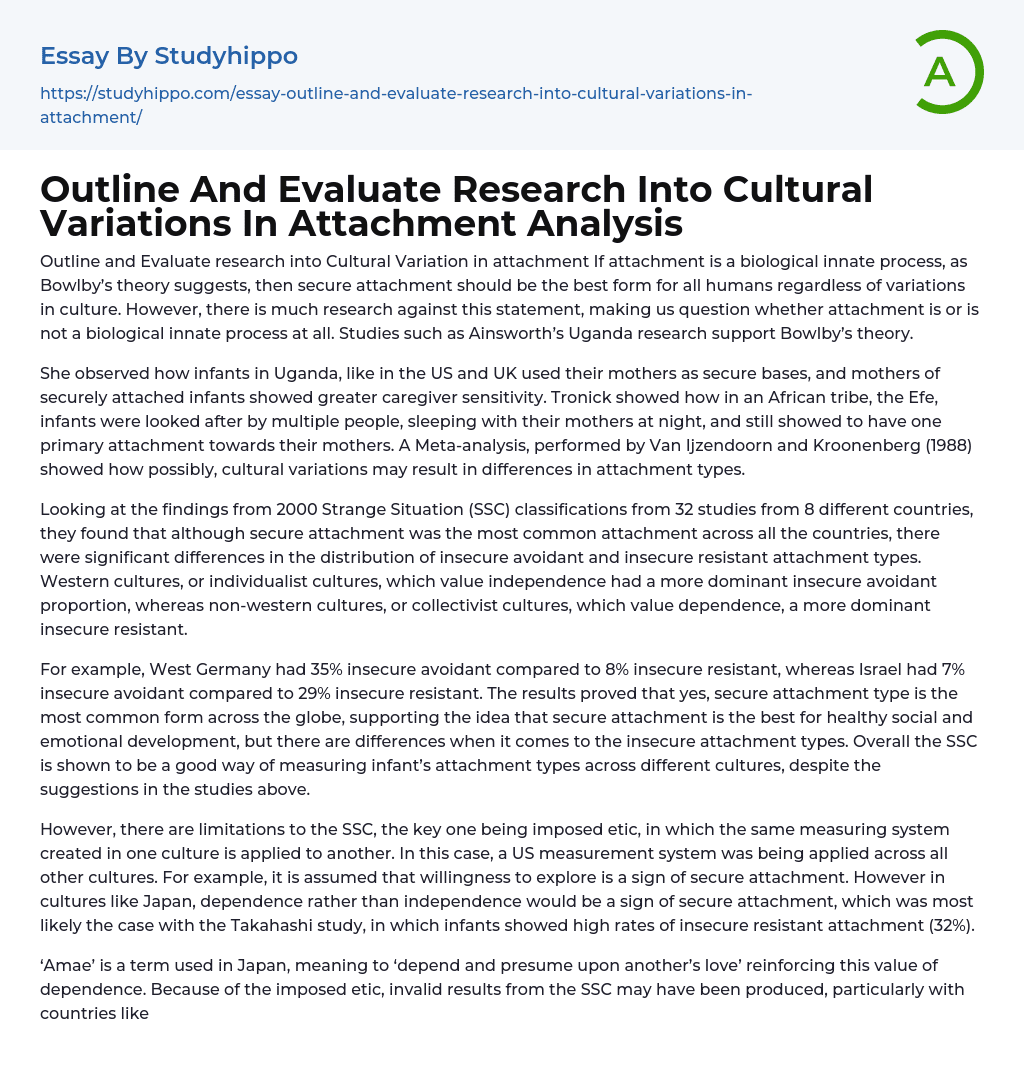

Outline And Evaluate Research Into Cultural Variations In Attachment Analysis Essay Example
Outline and Evaluate research into Cultural Variation in attachment If attachment is a biological innate process, as Bowlby’s theory suggests, then secure attachment should be the best form for all humans regardless of variations in culture. However, there is much research against this statement, making us question whether attachment is or is not a biological innate process at all. Studies such as Ainsworth’s Uganda research support Bowlby’s theory.
She observed how infants in Uganda, like in the US and UK used their mothers as secure bases, and mothers of securely attached infants showed greater caregiver sensitivity. Tronick showed how in an African tribe, the Efe, infants were looked after by multiple people, sleeping with their mothers at night, and still showed to have one primary attachment towards their mothers. A Meta-analysis, performed by Van Ijzendoorn and Kroonenberg (1988) showed how possibly,
...cultural variations may result in differences in attachment types.
Looking at the findings from 2000 Strange Situation (SSC) classifications from 32 studies from 8 different countries, they found that although secure attachment was the most common attachment across all the countries, there were significant differences in the distribution of insecure avoidant and insecure resistant attachment types. Western cultures, or individualist cultures, which value independence had a more dominant insecure avoidant proportion, whereas non-western cultures, or collectivist cultures, which value dependence, a more dominant insecure resistant.
For example, West Germany had 35% insecure avoidant compared to 8% insecure resistant, whereas Israel had 7% insecure avoidant compared to 29% insecure resistant. The results proved that yes, secure attachment type is the most common form across the globe, supporting the idea that
secure attachment is the best for healthy social and emotional development, but there are differences when it comes to the insecure attachment types. Overall the SSC is shown to be a good way of measuring infant’s attachment types across different cultures, despite the suggestions in the studies above.
However, there are limitations to the SSC, the key one being imposed etic, in which the same measuring system created in one culture is applied to another. In this case, a US measurement system was being applied across all other cultures. For example, it is assumed that willingness to explore is a sign of secure attachment. However in cultures like Japan, dependence rather than independence would be a sign of secure attachment, which was most likely the case with the Takahashi study, in which infants showed high rates of insecure resistant attachment (32%).
‘Amae’ is a term used in Japan, meaning to ‘depend and presume upon another’s love’ reinforcing this value of dependence. Because of the imposed etic, invalid results from the SSC may have been produced, particularly with countries like Japan. Another limitation is that attachment types tend to be generalised for the whole of the country. However, there are subcultures, such as rural and urban societies, which may have differences in attachment types themselves. Urban societies could be the same for Japan and US, the same with rural, making generalisation of a whole country from a few studies possibly seen as unfair.
- Abnormal Psychology essays
- Abraham Maslow essays
- Attachment Theory essays
- Authority essays
- Behaviorism essays
- Classical Conditioning essays
- Cognitive Psychology essays
- Counseling essays
- Developmental Psychology essays
- Educational Psychology essays
- Erik Erikson essays
- Family Therapy essays
- Jean Piaget essays
- Maslow's Hierarchy Of Needs essays
- Mental Health essays
- Operant Conditioning essays
- Personality Psychology essays
- Positive Psychology essays
- Psychoanalysis essays
- Psychotherapy essays
- Sigmund Freud essays
- Social Psychology essays
- Stanford Prison Experiment essays
- Supersize Me essays
- American Dream essays
- Barriers To Entry essays
- Capitalism essays
- Central Bank essays
- Compensation essays
- Consumerism essays
- Economic Development essays
- Economic Growth essays
- Economic Inequality essays
- Economic System essays
- Economy essays
- Employment essays
- Export essays
- Finance essays
- Free Trade essays
- Gross Domestic Product essays
- Human Development essays
- Income Inequality essays
- Industry essays
- Inflation essays
- International Business essays
- International Trade essays
- Macroeconomics essays
- Materialism essays
- Max Weber essays
- Microeconomics essays



